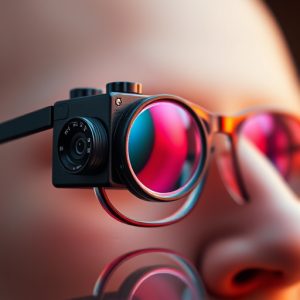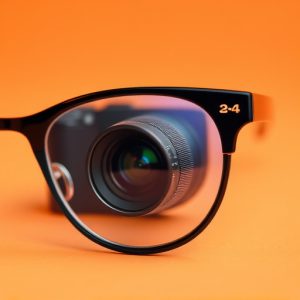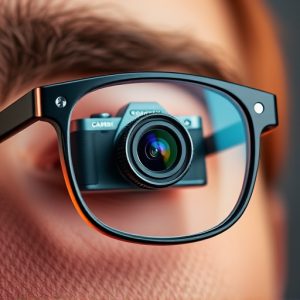Smart Glasses Camera Quality Evolution: Miniaturization and Functionality
The evolution of glasses with a camera built in has transformed them from mere accessory items into…….
The evolution of glasses with a camera built in has transformed them from mere accessory items into advanced smart glasses that enhance both vision and interactive capabilities. These devices have transitioned from niche applications like video recording and augmented reality to becoming mainstream, allowing users to effortlessly capture images and videos through a first-person perspective while maintaining a sleek and fashionable design. The key to this progress lies in miniaturization advancements that enable cameras to be seamlessly integrated into glasses without compromising comfort or functionality. Today, these smart glasses serve diverse functions across various domains, from professional use to personal memory keeping, all while remaining discreet on the user's face. Future enhancements promise improved camera quality, longer battery life, and better data synchronization capabilities, with artificial intelligence set to expand their functionality even further, offering services like real-time language translation, enhanced navigation, and contextual information retrieval. The ongoing innovation in this field is redefining the user experience, hinting at a future where smart glasses not only aid vision but also revolutionize interaction with our surroundings, promising a new era of interconnected visual and computational technology that respects privacy and ethical considerations. Key advancements include high-resolution imaging sensors that address common lens issues, optical excellence that corrects for chromatic distortion, and state-of-the-art features like image stabilization and low-light performance, positioning these glasses as multifunctional devices suitable for both leisure and professional photography needs. As they become even more sophisticated, smart glasses with cameras built in have the potential to significantly enhance personal and professional imaging experiences responsibly.
In recent years, the integration of cameras into glasses has revolutionized personal optics, transcending mere visual aid into a multifaceted tool. This article delves into the remarkable evolution of smart glasses, focusing on how advancements in miniaturization have significantly enhanced their camera quality. We will scrutinize the imaging capabilities of these devices, examining resolution, sensors, and optical prowess. Furthermore, we’ll explore practical applications, from everyday use to advanced functionality, offering insights into the real-world impact of glasses with a camera built in. Join us as we peer through the lens of innovation to understand how these wearable wonders are redefining our interaction with the world around us.
Exploring the Evolution of Glasses with Built-in Cameras: A Technological Lens on Innovation
The advent of glasses equipped with built-in cameras has marked a significant milestone in the fusion of optical technology and digital innovation. From their early iterations as simple eyewear accessories to advanced smart glasses, this journey reflects a profound commitment to enhancing both visual clarity and interactive capabilities. Initially, glasses with a camera built in were primarily associated with niche applications like real-time video recording or augmented reality experiences. Today, these devices are becoming more mainstream, offering users the ability to capture images and videos seamlessly, as if through their own eyes. The evolution of this technology is driven by advancements in miniaturization, which allow for cameras to be integrated without compromising the comfort or functionality of the glasses. This integration has led to a variety of applications ranging from professional documentation to personal memory capturing, all while maintaining an unobtrusive presence on the user’s face.
As the technology continues to mature, we can expect further enhancements in camera quality, battery life, and data synchronization. The convergence of artificial intelligence with these devices promises to bring even more utility to wearers, from real-time language translation to advanced navigation and contextual information retrieval. The potential for these smart glasses is vast, touching on fields as diverse as healthcare, education, and entertainment. With each new model, the boundary between traditional eyewear and personal computing equipment blurs, offering a glimpse into a future where our vision not only helps us see but also interact with the world around us in profoundly new ways. The trajectory of glasses with a camera built in is one of continuous innovation, poised to redefine how we experience and capture the world through the technological lens of smart eyewear.
The Impact of Miniaturization on Camera Quality within Wearable Devices
The miniaturization trend within wearable technology, particularly in glasses equipped with cameras, has had a profound impact on camera quality. As components become smaller and more efficient, designers are able to integrate high-resolution cameras directly into the frames of these devices without compromising on size or aesthetics. This advancement allows users to capture images and videos with greater clarity and detail than ever before, all while maintaining a form factor that is unobtrusive and suitable for everyday use. The compact nature of these cameras also means that they can be positioned strategically within the glasses to minimize any visual intrusion, ensuring that the camera glass does not protrude and remains stylish and comfortable.
Furthermore, the integration of sophisticated imaging sensors into glasses with built-in cameras has led to significant improvements in low-light performance and dynamic range. The shrinking of these sensors has not diminished their capacity to capture a wide spectrum of colors or their ability to adjust to various lighting conditions seamlessly. This progression has made wearable cameras increasingly versatile, capable of producing high-quality visuals that rival those from traditional standalone cameras. As miniaturization continues to advance, the potential for even more sophisticated and high-quality camera functionality within glasses is boundless, promising a future where capturing life’s moments is as natural and effortless as breathing.
Assessing the Imaging Capabilities of Smart Glasses: Resolution, Sensors, and Optical Excellence
smart glasses with cameras have become increasingly sophisticated, offering users a glimpse into augmented reality (AR) and the ability to capture moments with ease. Assessing their imaging capabilities requires a close look at three key components: resolution, sensors, and optical excellence. Resolution is paramount in delivering crisp, detailed images; higher resolutions ensure that the visuals captured through these glasses are sharp and vivid, akin to what one would expect from high-end smartphones. The integration of advanced sensors plays a crucial role in capturing accurate color representation and dynamic range, which together contribute to the overall quality of the photographs or videos taken. These sensors help mitigate common issues such as lens flares or ghosting, commonly encountered in lower-quality camera lenses.
Optical excellence is another aspect that distinguishes high-performing smart glasses with a built-in camera from their less capable counterparts. It encompasses the quality of the optics and how well they can correct for aberrations like chromatic distortion, which can affect image clarity. Additionally, the ergonomic design of these devices should not compromise the visual experience; rather, it should optimize field of view and provide a seamless transition between the digital and real-world environments. Advanced models may also include features like image stabilization and enhanced low-light performance, further elevating their imaging capabilities to rival traditional standalone cameras, making them versatile tools for both personal use and professional applications.
Practical Applications and Considerations for Glasses with Integrated Cameras: From Daily Use to Advanced Functionality
Glasses with a camera built-in are rapidly transforming the way individuals interact with their surroundings, offering enhanced capabilities that go beyond mere vision correction. In daily use, these smart glasses serve as a personal assistant, capturing images and videos with ease, ideal for documentation, quick sharing of moments, or even hands-free photography. The integration of cameras into eyewear opens up a plethora of practical applications, from recording life’s fleeting moments to assisting in tasks that require visual documentation. For instance, professionals who need to keep their hands free, such as surgeons or mechanics, can benefit from this technology, which allows them to capture high-quality images without the need for additional equipment.
Beyond daily use, advanced functionality is where these devices could truly shine. Imagine glasses that can provide real-time language translation, offer augmented reality overlays for navigation and information display, or even assist in medical diagnoses by capturing detailed visuals of a patient’s condition. The potential for integration with artificial intelligence and machine learning technologies is vast, enabling the glasses to identify objects, people, or even gestures, providing an interface between human interaction and digital systems. As these devices evolve, considerations such as data privacy, user consent, and ethical use will be paramount to ensure the responsible adoption of this powerful technology. It’s crucial for manufacturers to address these concerns proactively, ensuring that users can trust and safely incorporate glasses with a camera built-in into their daily lives.


